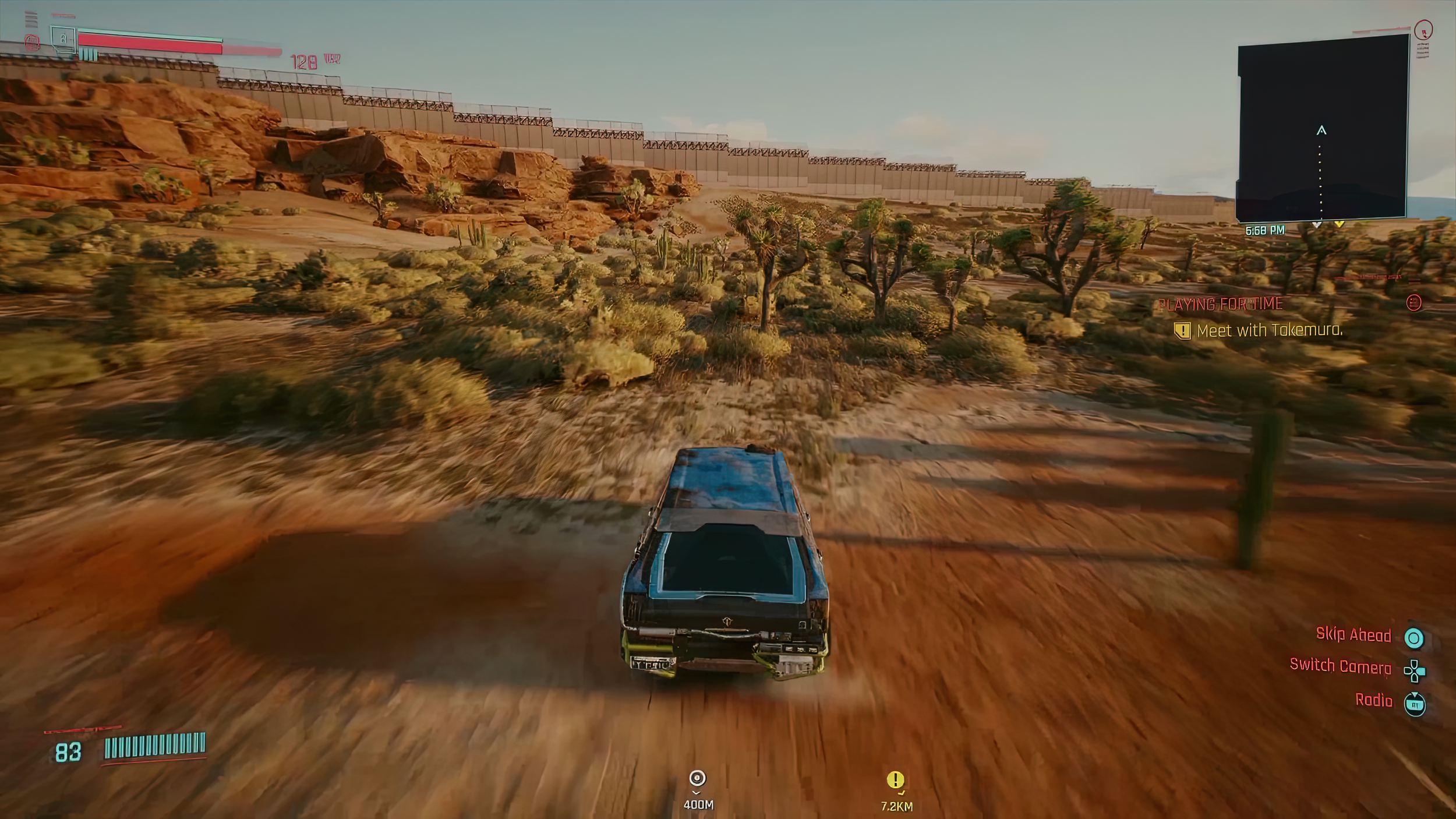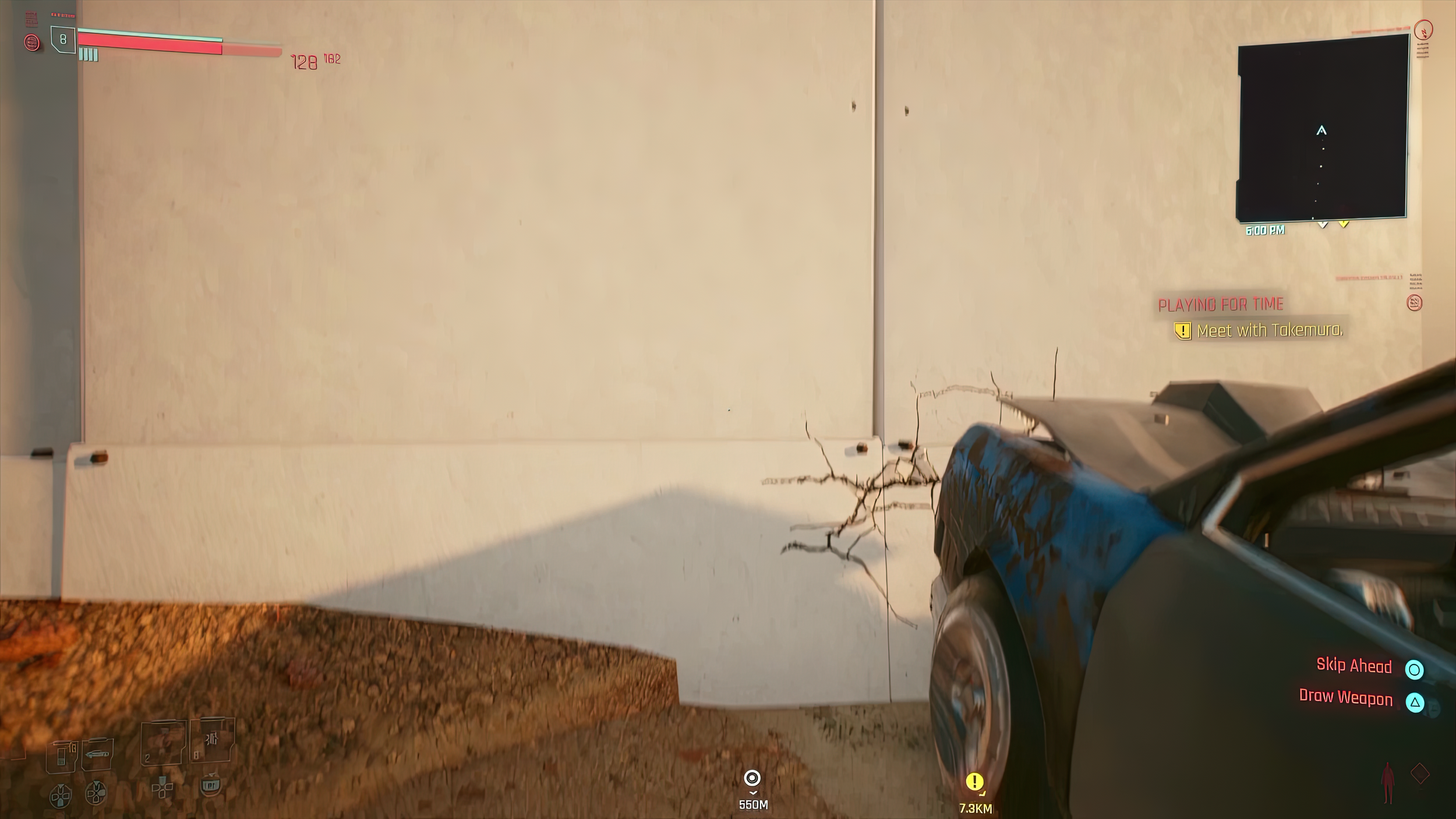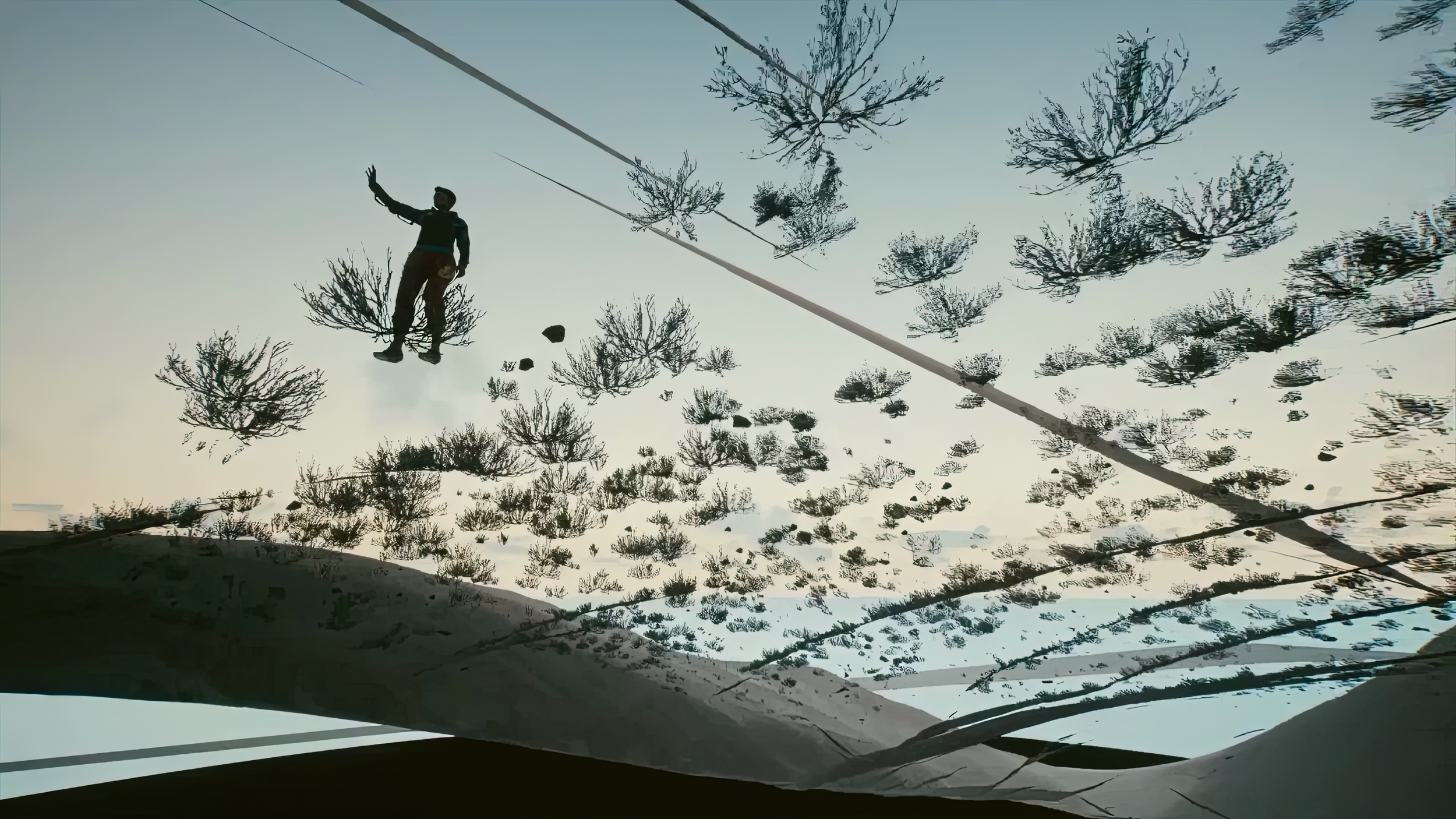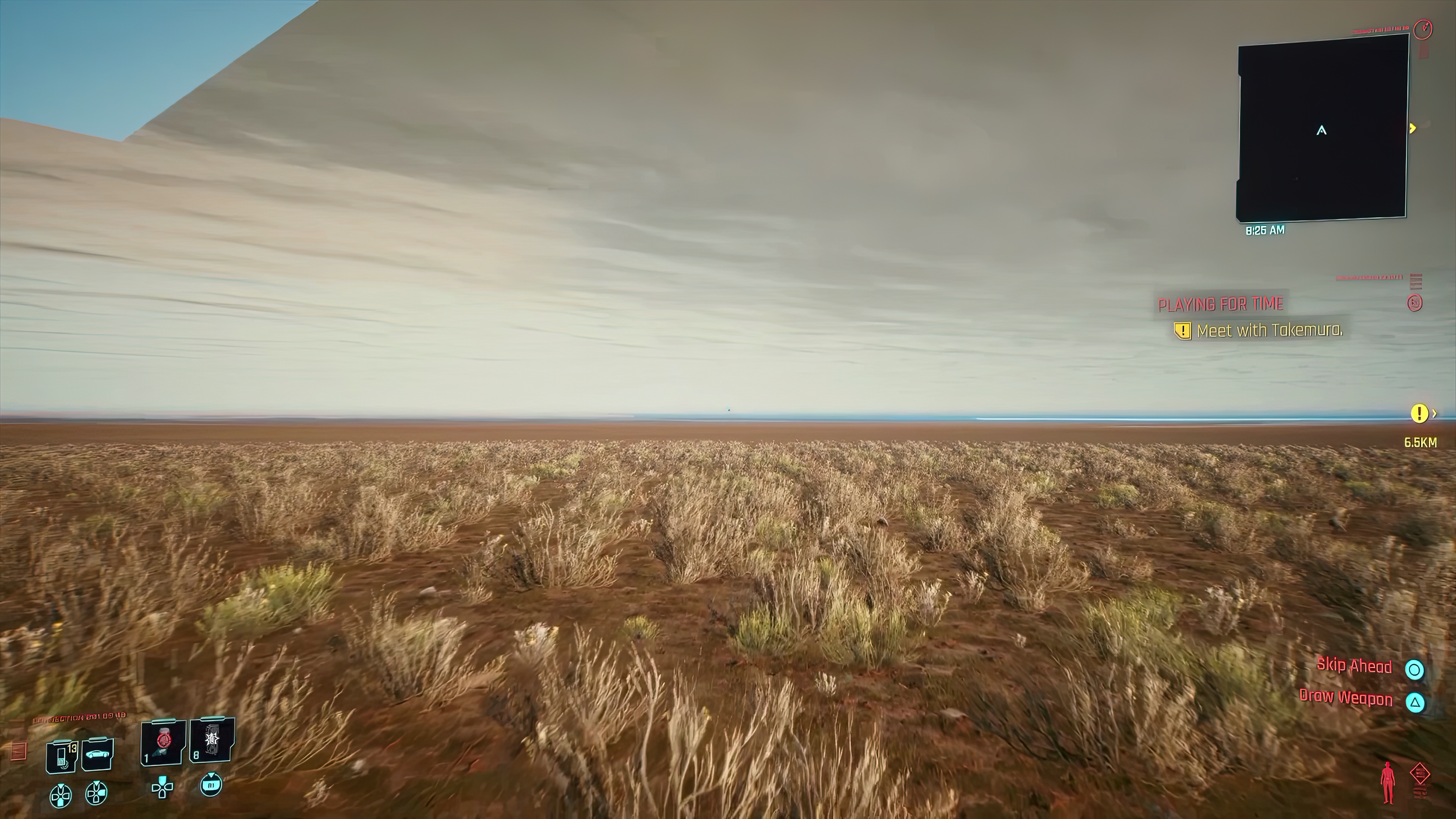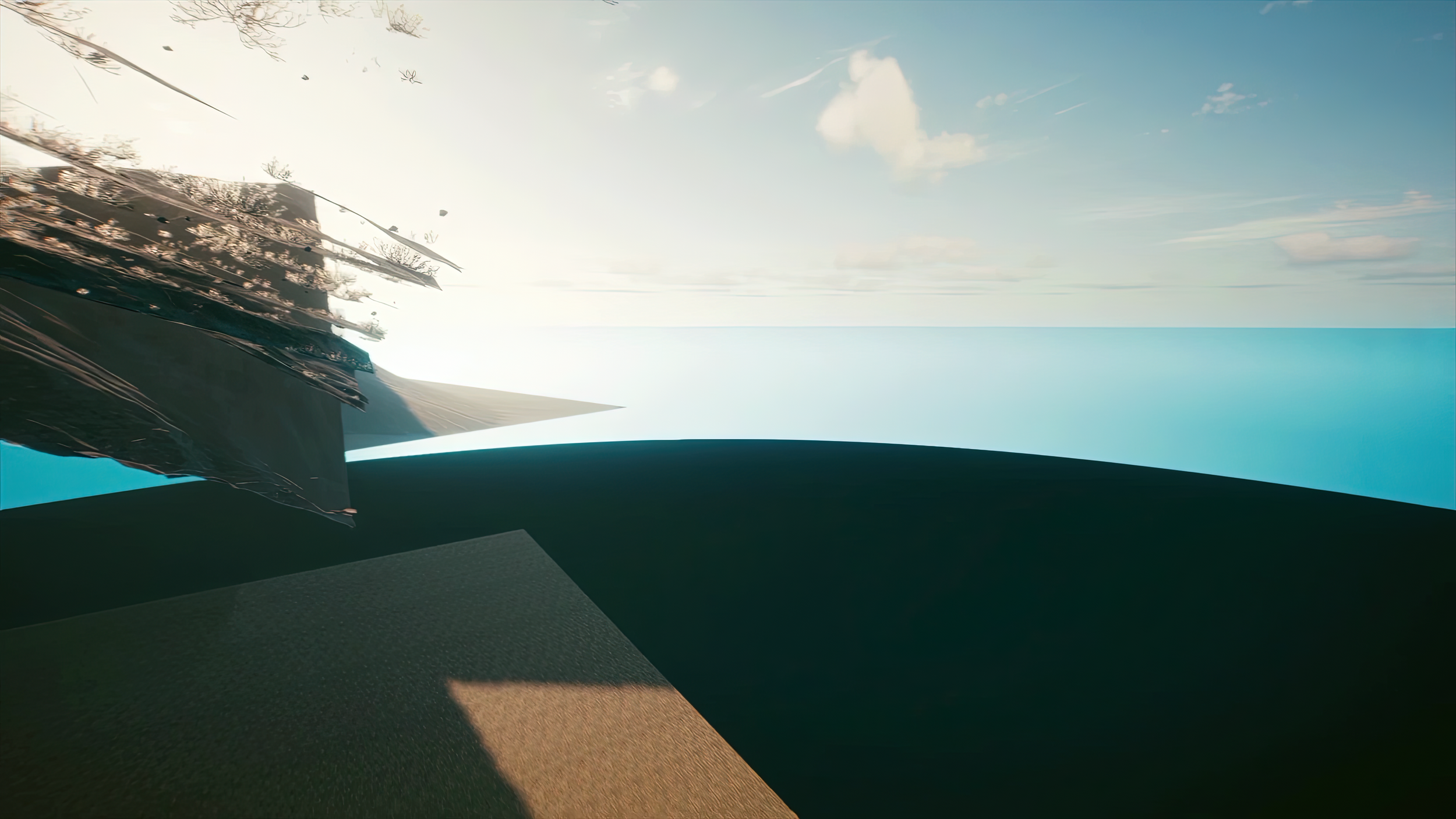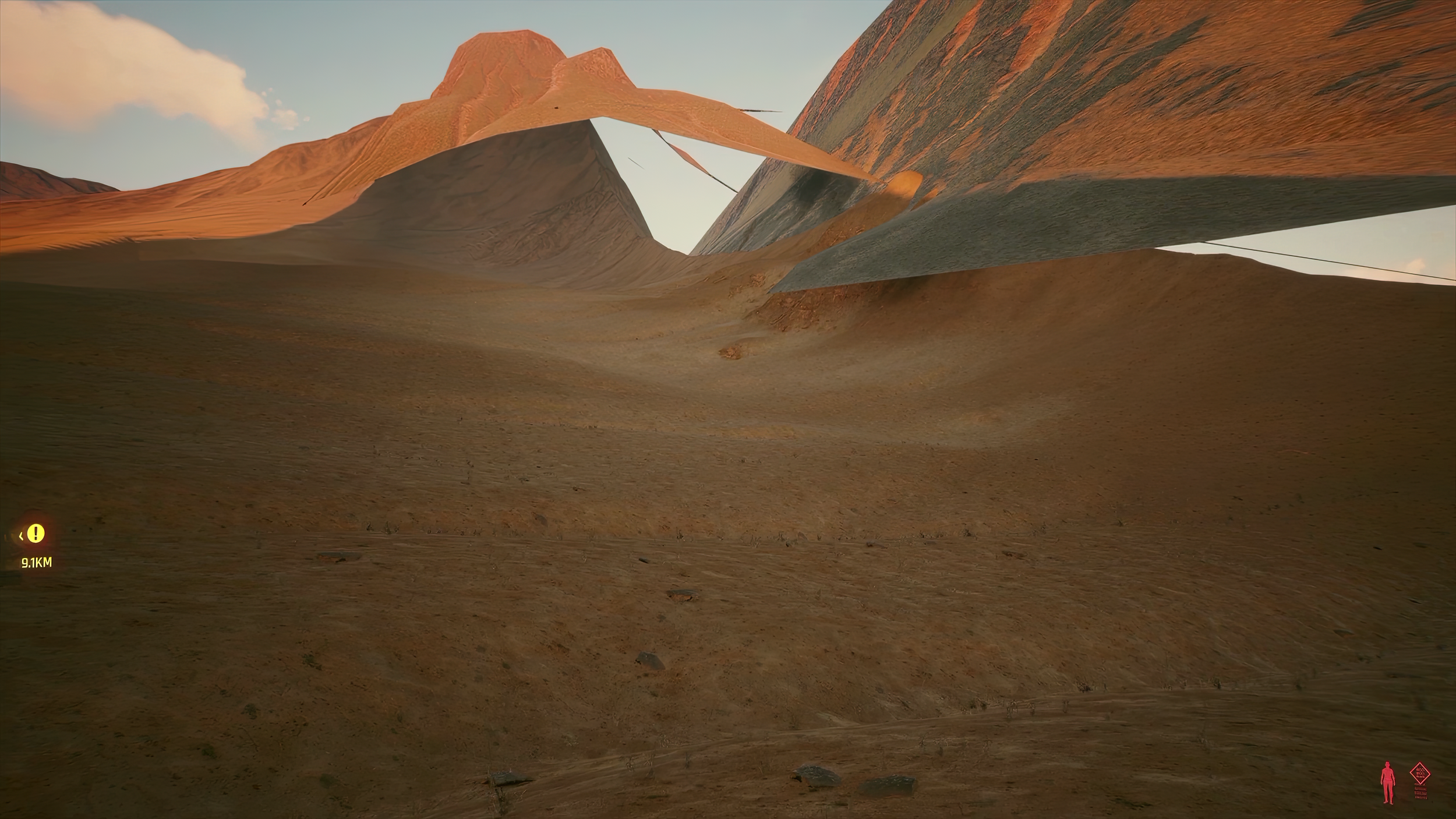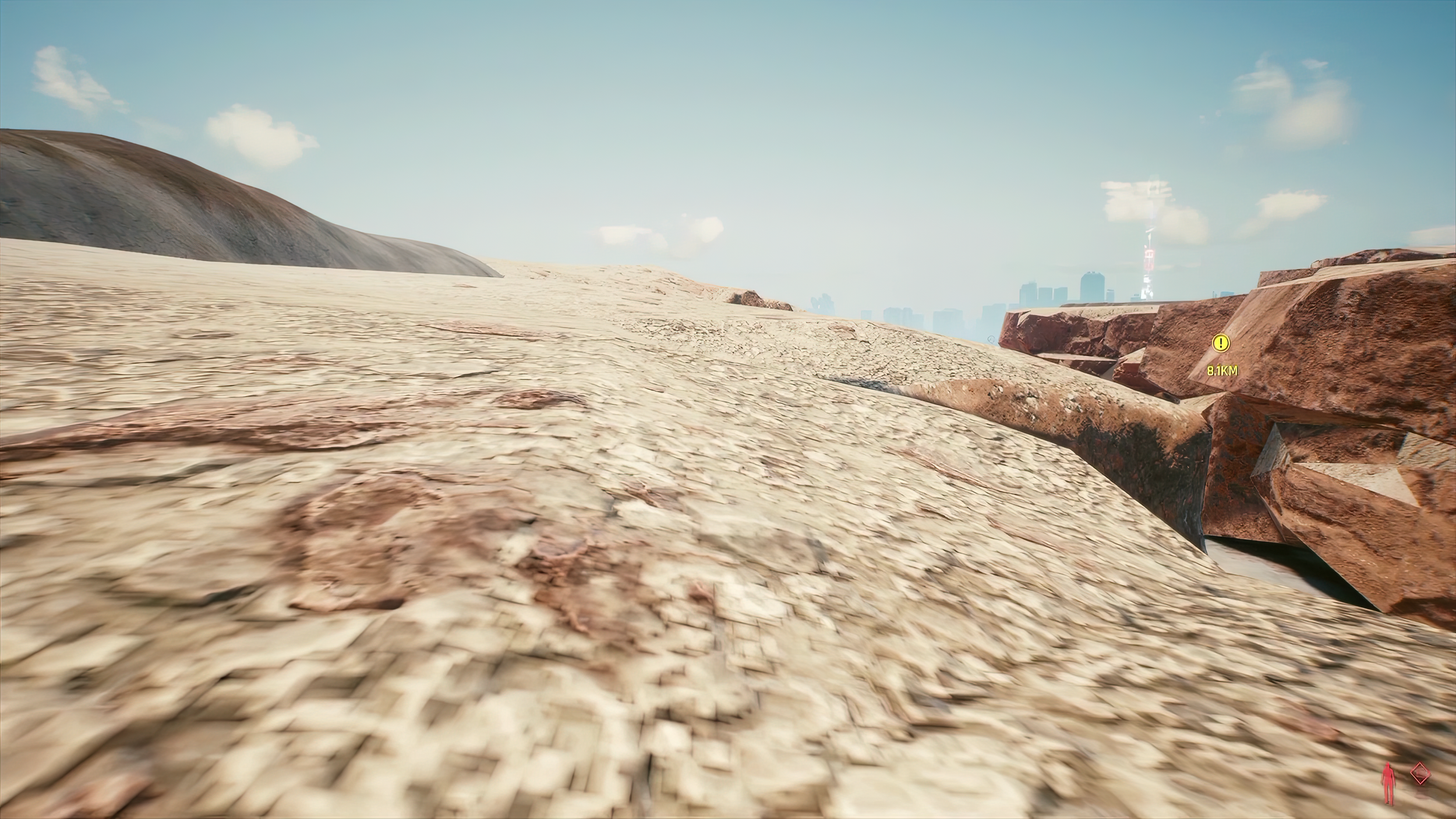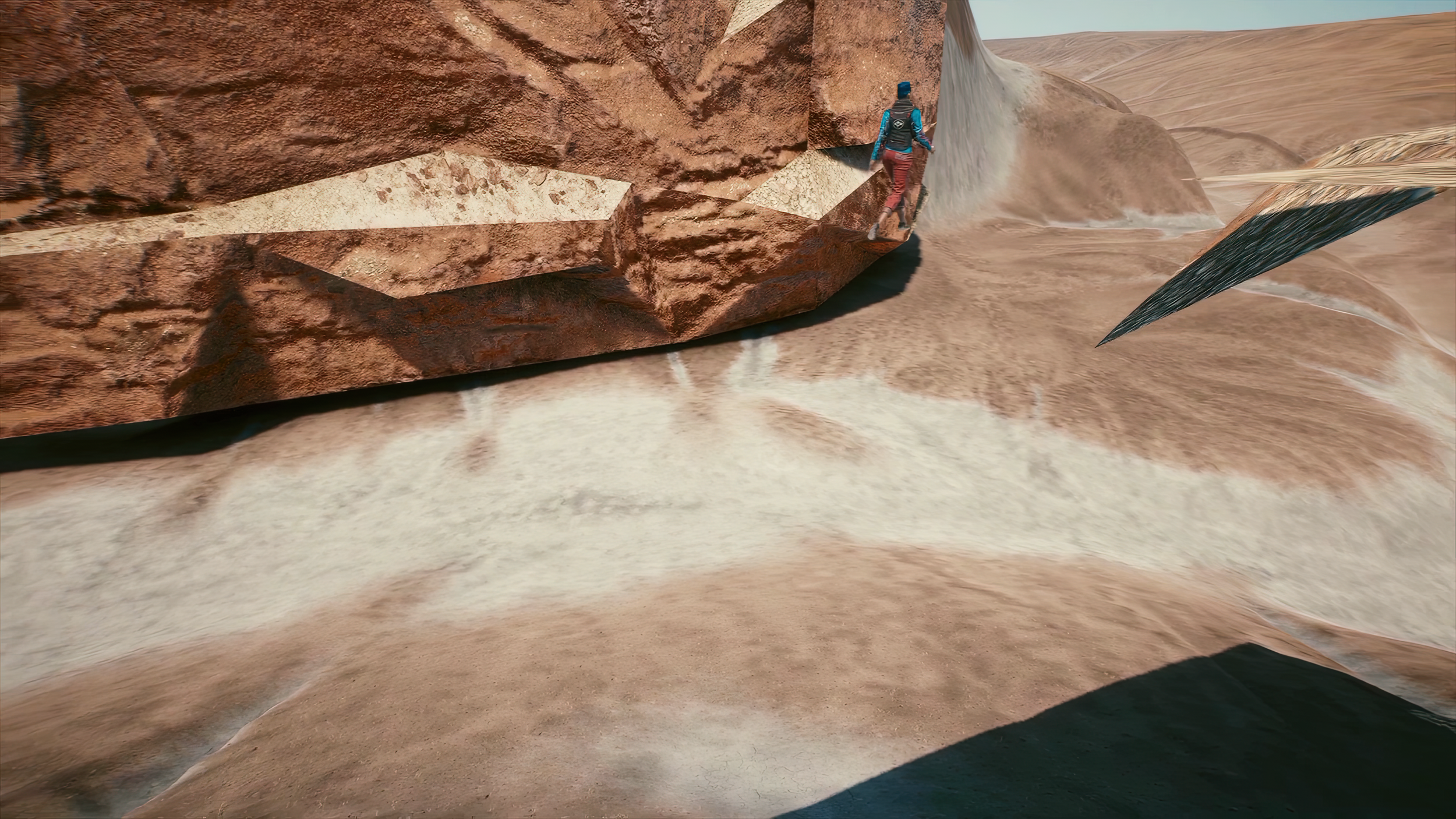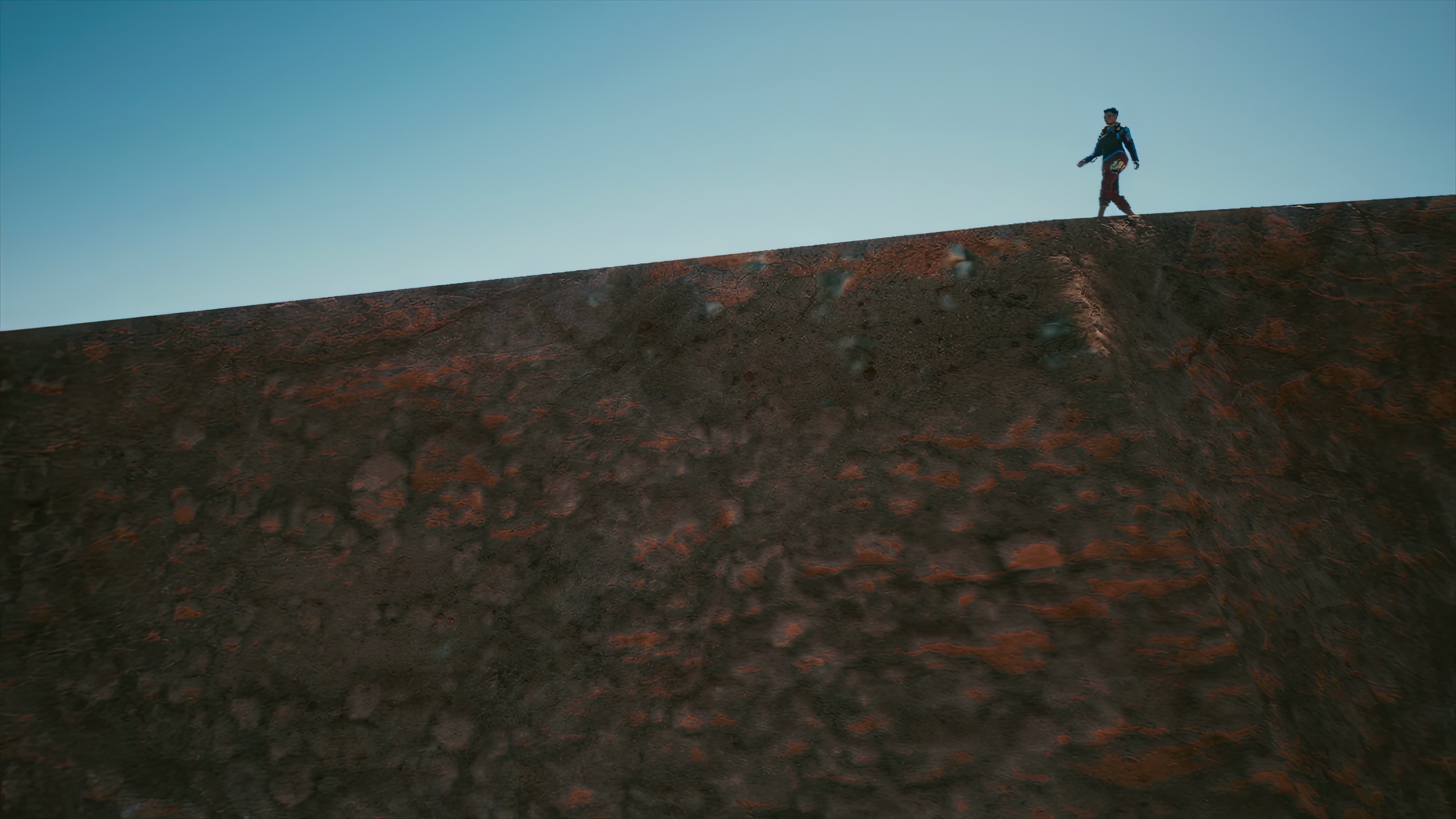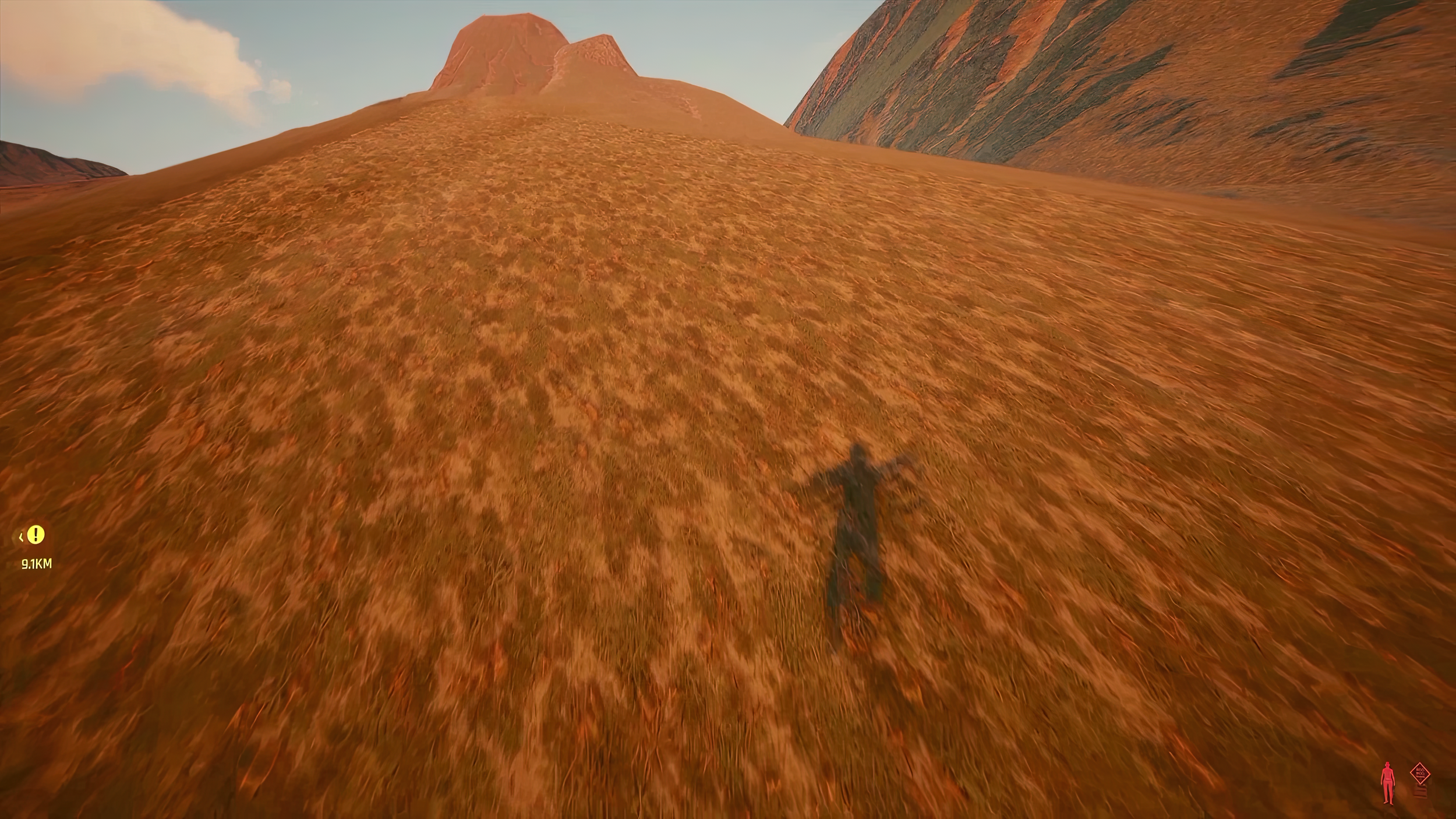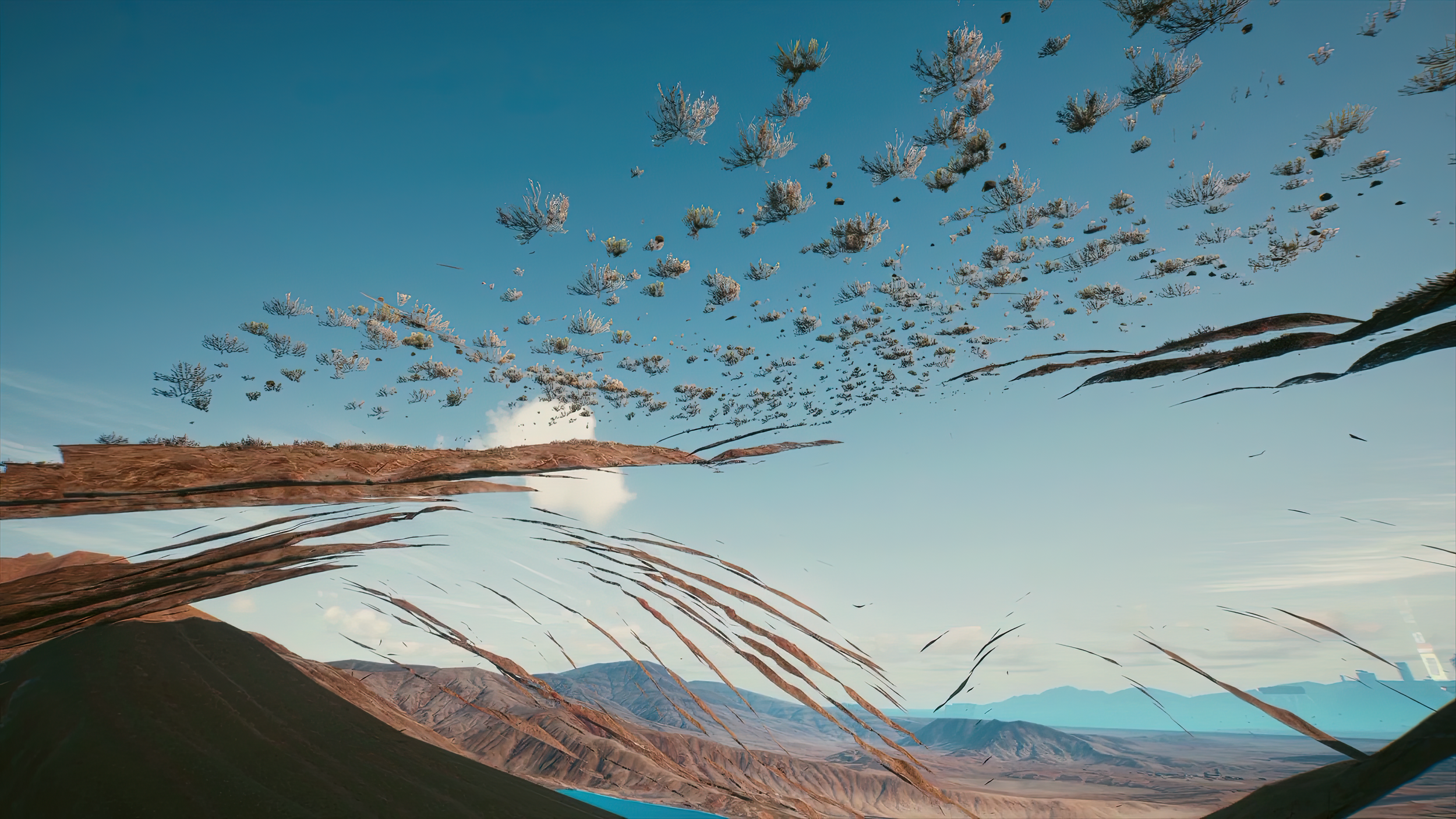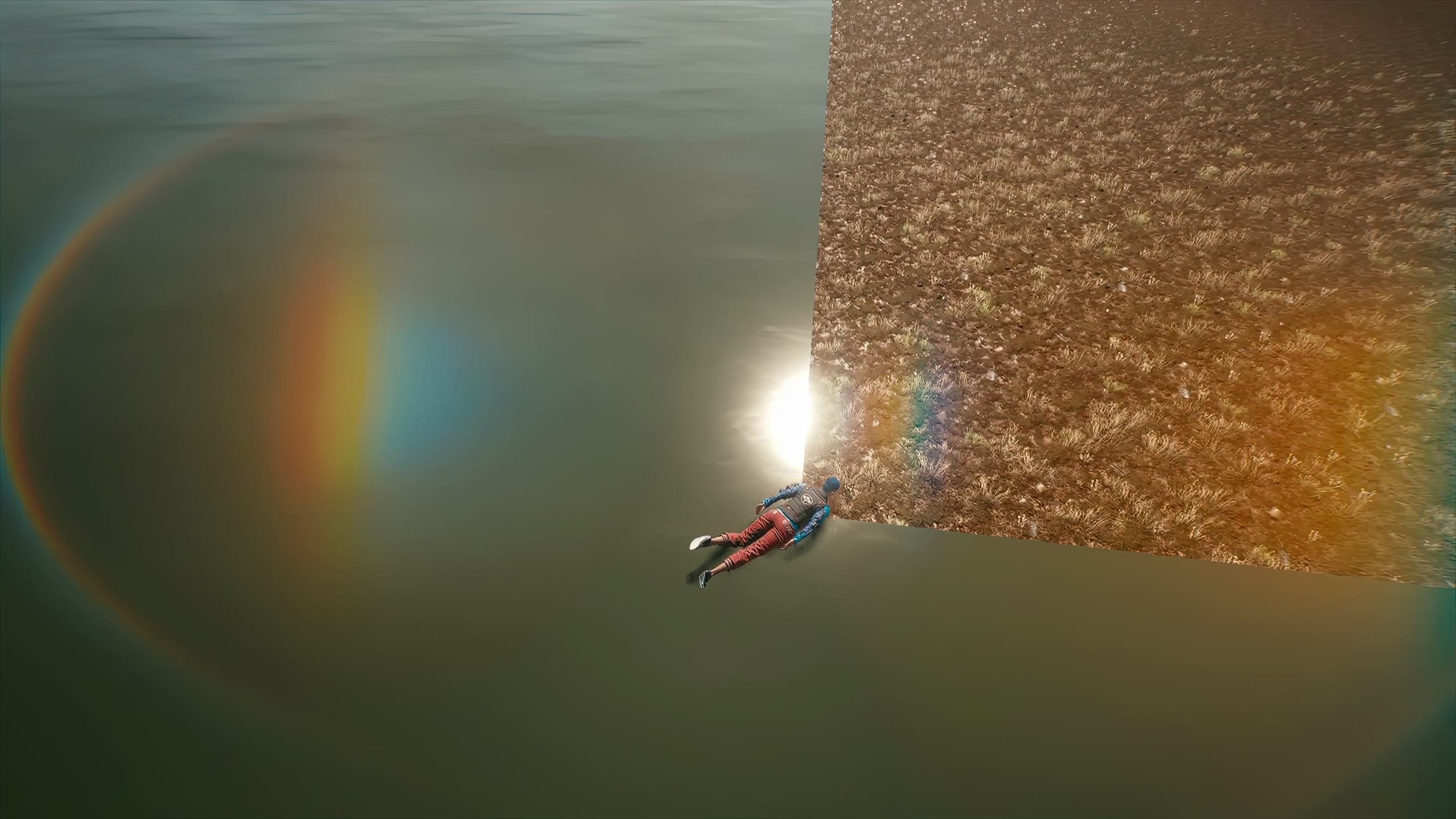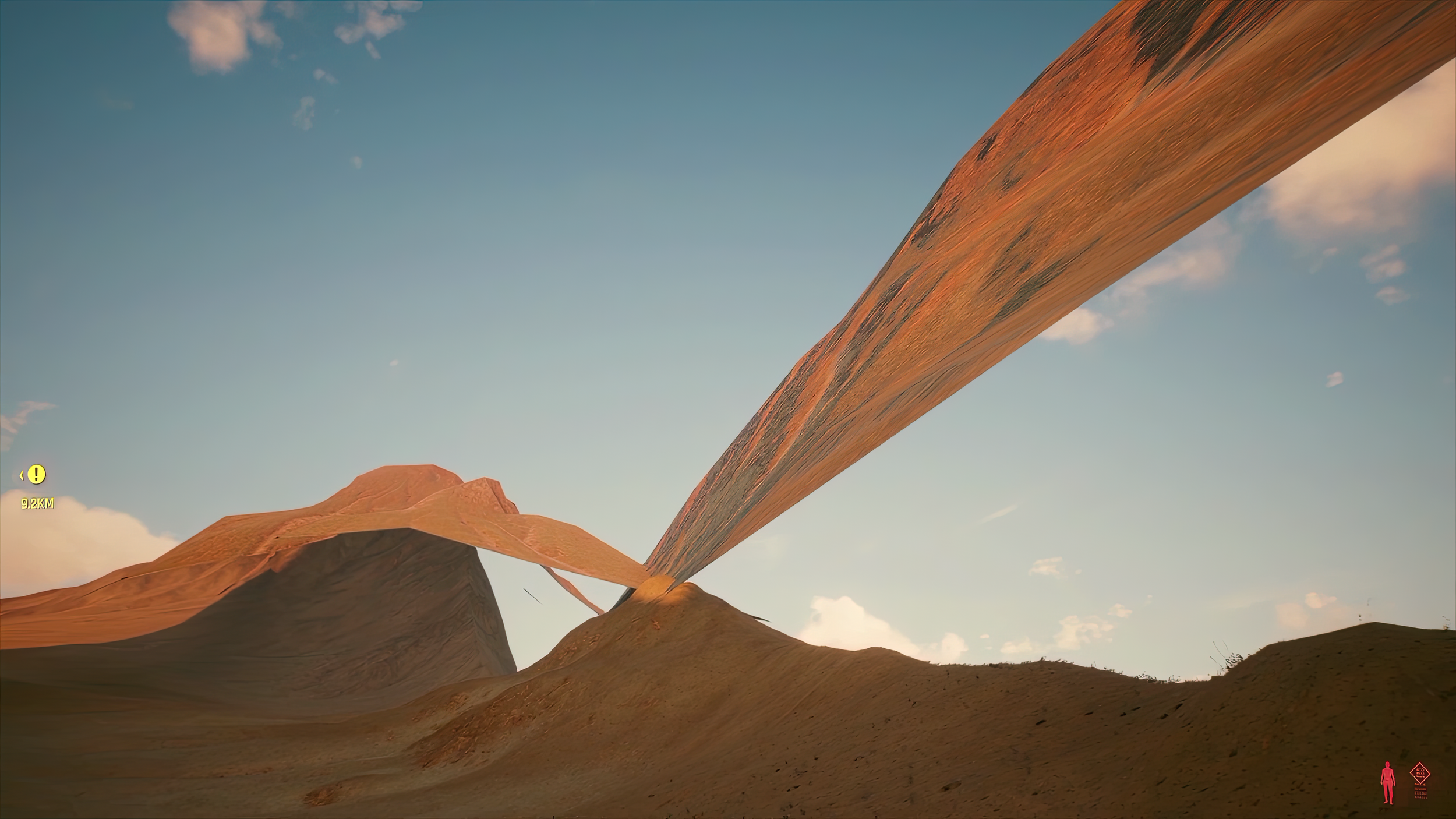The Edge of the World
machinima/digital video, color, sound, 8’ 50”, Russia, 2021
Created by Natalie Maximova
A video work that delves into the expansive and boundary-pushing landscapes of the sci-fi video game Cyberpunk 2077, The Edge of the World challenges the conventional perception of endless landscapes, prompting the viewer to question the existence – and perhaps the very meaning – of limits. By exploring the concealed boundaries, documenting the “raw edges” of the game world, and revealing the underlying representational principles, the artist suggests that digital reality is a culturally constructed product. The edges of these virtual realms, with their idiosyncrasies and unexpected functionalities, are not mere endpoints. Instead, they evoke the edges of our familiar world, inviting contemplation and reflection.
Natalie Maximova is an interdisciplinary artist and photographer based in Lausanne, Switzerland. She holds a degree from the ECAL/Ecole cantonale d’art de Lausanne and has also studied at the Rodchenko Moscow School of Photography and Multimedia. Maximova’s work has been featured in numerous exhibitions worldwide, including the 6th and 4th Moscow International Biennale for Young Art, the Moscow Biennale of Contemporary Art, Balagan!!! Contemporary Art from Russia and Other Mythical Places in Kühlhaus Berlin and the Tbilisi Night of Photography. Her artworks are included in the permanent collections of the Multimedia Art Museum in Moscow and the CitizenM Hotel in Geneva. Maximova’s work has been featured in several publications including Il Giornale dell’Arte, Camera Austria, Bird in Flight, Calvert Journal, and Vice among others. She has also contributed to Screen Images In-Game Photography, Screenshot, Screencast, edited by Winfried Gerling, Sebastian Möring and Marco De Mutiis and published by Kulturverlag Kadmos in 2023.
Matteo Bittanti: The Edge of the World is both a creative and critical exploration of Cyberpunk 2077’s landscapes. Could you provide insight into the inspiration behind your project? What sparked your curiosity? Could you illustrate your meticulous creative process, unveiling the evolution of your ideas from conception to the final execution of the series? How did you navigate the vast virtual realm of this sci-fi open world game, selecting the specific landscapes to capture?
Natalie Maximova: I’ve been fascinated by the liminal zones and the complex and ambiguous notion of landscape since I started my artistic practice as a documentary photographer, with a particular focus on capturing the stories that often go unnoticed or even avoided. I decided to step back from documentary photography after a few years of practice, and got into video art and video game studies. This shift led me to explore constructed and virtual representations of landscapes, such as those found within video games, virtual realities, and simulations.
I like the idea that video game landscapes could be thought of as a system consisting of natural, man-made, and cultural forces that can be identified and studied. In this context, the landscape serves as a medium that combines, holds, and channels these forces. I’ve especially loved the so-called “walking simulators” and have been building my research mainly around these types of games. This genre severely limits our interaction with the game world, removes the pressure from the player, and encourages slow movement within an ad hoc environment, making the experience more atmospheric and contemplative. However, it can also be associated with ambivalence and anxiety due to the absence of familiar gameplay patterns.
Just before the Covid-19 pandemic, I moved to Switzerland and got myself a PS4. Back then, I found myself stuck at home delivering parcels in Death Stranding, expanding my research on open-world games. During that period, I embarked on crafting my thesis focused on depicting landscapes within video games. As a Master’s student at ECAL, I received exceptional backing from Marco de Mutiis, the instructor leading our course dedicated to automation in photography. His unwavering support enabled me to conduct diverse experiments with video games, which ultimately sparked a re-evaluation of my perspectives on in-game photography, making his course a particularly inspiring experience.
Cyberpunk 2077 had just been released and was one of the most anticipated games of the year. However, it failed at launch, or at least the majority of players thought so, due to the enormous amount of glitches and faults that made it basically unplayable. It was even removed from the PlayStation store. The main story in Cyberpunk 2077 follows the struggle of the character as their brain overwrites cybernetic implant malware. This means that glitches, or more accurately, their representation, are embedded in the storyline, cut scenes, and gameplay. Nevertheless, Cyberpunk 2077 failed spectacularly, even though the game itself revolves around a kind of failure that mirrors its own. Exploring and challenging the spatial confines of a newly released game in its unpolished state can yield fruitful results, unveiling hidden facets beyond the game's intended experience and revealing the raw essence of the digital world. . It’s akin to venturing backstage.
And just like that, I embarked on a journey to seek the edge of the virtual world of Cyberpunk 2077. Following the horizon, that elusive edge of the land itself, that peculiar part of the life-world that refuses to be an object. I wandered until I literally hit an immense concrete wall fortified with barbed wire. This structural border of the virtual world, akin to a frame of the painting or photograph, separates me from something that was never meant to be seen. Ironically, I stumbled upon an actual hole in the wall and squeezed through this hole, straight into the unknown. From that moment on, a whole new adventure beyond the map began. This also began to shape the narrative of my work from that point onwards. I would say that my approach aligns with what is described as virtual-world naturalism and picks up a lot from my background in documentary photography. Our engagement with the landscape, and with the places that are found within it, plays a fundamental role in the way we find and position ourselves in the world. Not only one’s personal world but the worlds of history, culture, environment, and nature. The virtual world of video games is no exception. When I find myself within a particular location, I take the time to explore, investigate, observe, and document. In the midst of this field study, the landscape undergoes a remarkable transformation, evolving from a mere backdrop to a prominent protagonist.
Matteo Bittanti: Within the virtual spaces crafted by game designers, ambitious aspirations for totality often collide with various limitations, be they technical, architectonic, or even cultural in nature. In your artistic exploration, you speak of “concealed boundaries,” those enigmatic and latent demarcations that reside within a given space or context, eluding immediate visibility or recognition. Such concealed boundaries significantly shape our understanding and interactions with(in) video game spaces. Their unveiling becomes an immersive process, demanding meticulous exploration, astute observation, and a keen eye to uncover the hidden structures and underlying mechanisms that influence, if not shape, our experiences and perceptions in the game and of the game. How have your explorations within the world of Cyberpunk 2077 altered your understanding of virtual spaces and the intricate dynamics between concealed boundaries, hidden structures, and the profound impact they exert on our engagement with the digital realm?
Natalie Maximova: We are inclined to believe that landscapes are limitless, one vista always giving way to another, one stretch of land merging into the next. The virtual worlds of games are constructions and, as such, they necessarily have ultimate boundaries and limits. Boundaries in real life are inherently indeterminate and often change configuration. I found that even if the boundaries in virtual worlds seem to be more determined they also can drastically shapeshift. For instance, one day the patch or expansion can be released and the access to the “outside” is gone. Nevertheless, within virtual worlds, the boundaries or edges are not perceived as the ultimate or absolute ends of existence, but rather as the limits of our familiar understanding of the world. There may be unknown and unexplored spaces, inviting us to contemplate and maybe even expand our perception of reality. I like the idea that virtual worlds develop a sense of autonomy, acquiring a life of their own. Virtual environments possess their own unique characteristics, dynamics, and narratives that transcend their origins as mere reflections or replicas of the external world. It highlights the transformative power of virtual spaces and their capacity to shape and influence human experiences in ways that extend beyond simple replication or simulation.
The land of Cyberpunk 2077 seemed to me incredibly detailed, yet an infinite range of elements was missing. As Harun Farocki pointed out in Parallel III, “The objects have no existence besides themselves, they are by themselves nothing”. It’s a world without molecules, chemical reactions or atoms. Similarly, in his essay Virtual Reality: Fictional all the Way Down (and that’s OK), Danish scholar Jesper Juul writes that this reality is not just a technological implementation on a trajectory to perfection, but a cultural artifact which derives its value in part from its simplification and difference from its source material.
Borders and boundaries hold significant power in reality, even though they are often seen as imaginary or ideal constructs. They go beyond being simply useful and often act to determine entire histories, including personal, institutional, regional, and even global. The human eye naturally gravitates towards the edges, seeking out the margins. According to the Inuit people, valuable knowledge can be gained by observing these edges. This suggests that by paying attention to the edges, we can acquire a deeper understanding and insight. Having this in mind, I really enjoy exploring this erratic, rough edges of the game world. They embody aesthetic independence by rejecting conventions and serving no obvious utility, yet they give us new and often unexpected experiences.
Despite still feeling contained even outside the boundaries, I can sacrifice imposed gameplay, goals and optimisation for the act of flâneur-ing (wandering) and pure contemplation of the space itself. In his essay “The Aesthetics of Video Games”, Jesper Juul’s argues that eliminating a significant portion of challenges within a game allows players to liberate their mental resources for alternative undertakings. I agree wholeheartedly. This somewhat mirrors poetry or cinema, where the removal of expected structures, such as sentences or plot, encourages us to engage with the work in a more poetic manner, embracing allusions, wordplay, and subjective experiences.
Matteo Bittanti: Could you discuss some of the frustrations and unexpected functionalities that you encountered while exploring the edges of these virtual realms? I also wonder if these apparent technical dysfunctionalities are what make virtual experiences interesting in the first place, considering the abuse of archetypal situations, narrative tropes, and banal mechanics of most video games. In other words: isn’t “breaking the game” the most profound and gratifying experience of all?
Natalie Maximova: In linear or narrative games like The Last of Us, every step outside the game world becomes a struggle for survival. I find myself too cautious and preoccupied with finding the right path, which creates some sort of goal and makes achieving a state of explorative free flow more challenging. On the other hand, exploring beyond the boundaries in open world type of games is relatively safe and can even be relaxing. It allowed me to explore without the constant fear of death for an extended period of time. For me, being outside the boundaries or “breaking the game” is more gratifying and interesting than finishing the original game. Trespassing the digital boundaries creates alternative narratives and interpretations, disrupts the intended visual representation of the game world, challenges the limitations of virtual spaces uncovering a wide range of anomalies and hidden aspects of the virtual worlds. Although, not every game can be as rewarding as Cyberpunk 2077 in terms of glitches and access to the outside.
However, I also understand that a “broken game” can be disappointing and upsetting for players that have other challenges in mind, as evidenced by the numerous complaints and negative comments about Cyberpunk 2077 after its release. Nevertheless, just to compare the experiences, I also finished every existing quest in this game, went through all possible outcomes, found secret features and with them even more holes to get to a different out of the map place. I would say that I found more fulfillment and satisfaction in wondering beyond the boundaries as it had no actual ending. In contrast, finishing the actual game left me with a feeling of disappointment.
Matteo Bittanti: The Edge of the World brought to mind a comparable venture undertaken by the Australian collective The Grannies within Red Dead Redemption 2. In light of this connection, which may be intentional or not, my curiosity is piqued by the affective implications of your exploration. Could you describe the array of thoughts and emotions that emerged when confronted with the enigmatic “concealed boundaries” within these liminal, limbic spaces? Did their presence evoke in you a sense of disappointment, unmasking the inherent artificiality of these constructed worlds? Alternatively, did you experience a surge of surprise and excitement, as if stumbling upon forbidden, esoteric knowledge? Or perhaps your encounter evoked a nuanced blend of both emotions or something entirely distinct?
Natalie Maximova: Unfortunately, I haven’t had the opportunity to watch The Grannies yet. However, based on the info I found on the internet, it looks absolutely amazing. I am looking forward to catching up when possible.
For me the experience of navigating and exploring outside the virtual world was very poetic and felt similar to the explorations of the real world. There were moments when it felt just as exciting as discovering and documenting something hidden or inaccessible in real life. There were also moments of enchantment and following melancholy when the limit of the space was exhausted.
Throughout this journey, I felt quite close to the traditional forms of documentation, so photographing these environments also felt natural. Video recordings, on the other hand, gave me extra freedom to document the ambience and melancholy of these vast and suspended spaces including some unexpected audio glitches. There is a lack of typical in-game world noises and ambience; instead, the sound is extremely minimal or caught in a strange, endless loop. Audio effects may play at incorrect times or volumes. For example, the character’s footsteps are exaggerated and don’t necessarily match the landscape or surface.
Once, I stayed on a closed abandoned military island located in the far north of Russia. It was filled with decaying artifacts and endless miles of deserted roads where no one walked anymore. I aimlessly wandered for hours and days, hoping to find something useful for my project, navigating the vast landscape without a map, GPS, or internet connection. The atmosphere was very dense, as if the sound struggled to penetrate the air. It was eerily quiet, despite the presence of the sea. There were only my heavy steps, unexpectedly loud. It felt similar to walking outside the world of Cyberpunk 2077, creating an uncanny resemblance for me that certainly blurred the boundaries between the virtual and physical realms.
Matteo Bittanti: A key distinction between The Edge of the World and The Grannies (I’m referring to the superb documentary produced by Nick Murray and Marie Foulston, not the collective itself) is the format: you choose static images over animation. In this sense, your work is more reminiscent of Robert Overweg’s seminal series The End of the Virtual World. Were there any particular challenges you faced while transforming your digital photographs into a cohesive digital video piece? What were your guiding principles in creating the sequence? And what is your take on the practice of in-game photography?
Natalie Maximova: The End of the Virtual World, authored by Robert Oveweg, holds a special place in my heart as a project that I wholeheartedly adore. It stands among my personal favorites, and I feel deeply honored to be mentioned in the same breath as this remarkable endeavor. I come from a classical photography background where I preferred to use middle format film cameras so focusing on framing and waiting for the right conditions were crucial and slowed down the process significantly. However, in the context of this project, capturing both photographs and videos became one seamless process for me. As mentioned earlier, my intention with video was to convey the atmosphere and ambiance, while using the photo mode allowed me to be more flexible in framing the landscape. I found myself drawn to the automated and almost otherworldly camera movements and rotations, similar to manipulating assets in 3D software. Fortunately, the camera mode in the game wasn’t too restrictive.
I think that in-game photography is a significant cultural practice and an emerging field of study. It has gained more popularity recently largely due to the increasing visual fidelity and immersive nature of video game worlds. A multitude of contemporary games now incorporate a dedicated photo mode, enabling players to capture breathtaking artistic shots reminiscent of traditional photography. In some games, photo mode can even act as a distraction from the gameplay itself, as I experienced with Horizon Forbidden West, for example.
In my artistic practice I use photo mode as a tool that helps to challenge the boundaries and limitations of digital spaces and to subvert the intended visual and spatial design of the game. By navigating forbidden or inaccessible areas I try to highlight the permeability of these virtual environments. I also see in-game photography as a powerful tool for creation of alternative narratives and interpretations. It’s interesting to look at how we can further use virtual photography to gain a deeper understanding of the digital world mechanics, explore how glitches disrupt traditional visual expectations, challenge notions of beauty and explore concepts such as the sublime, the uncanny, or the aesthetics of imperfection.
Matteo Bittanti: Drawing inspiration from the aesthetic, mechanics, and logics of video games, your most recent artistic practice has been intimately intertwined with this interactive medium. Over the past few years, particularly since the onset of 2020, I have observed a notable transformation in your creative output. This evolution prompts me to inquire about the driving forces behind this shift. Could you elaborate on the reasons that compelled you to venture into the virtual, following a significant period of documenting the so-called IRL experiences? What motivated this departure? How has this exploration of the virtual realm influenced your artistic process, conceptual framework, and the visual language you employ?
Natalie Maximova: When I decided to shift away from documentary photography, my initial intention was to delve more into the realm of cinema. Nevertheless, as a staunch advocate of independent work, I found myself less enamored with pursuing the documentary route, despite its potential for solo filmmaking endeavors. Instead, I found myself drawn towards constructing and reimagining narratives in various contexts, utilizing photography or real-life video footage, but with increasingly conceptual outcomes. At that time, my focus was primarily on the notion of landscape, exploring its possibilities and differences. Naturally, this led me to research landscape virtual representations and look more into video games and virtual realities. It was around this time that a friend, who is now a talented video game researcher and writer for a game studies magazine, introduced me to the field of video game studies. Despite not being allowed to have a console or play video games at home during my childhood, I had always been a passionate fan and would often find ways to sneak into my friend’s houses or internet clubs to play video games. Eventually, I applied for the ECAL Masters course because it had an interesting research branch dedicated to automation and augmentation in photography. Throughout my studies, I decided to focus as much as possible on video games, simulations, and computer-generated environments, and I have continued ever since. This transition has also encouraged me to embrace an interdisciplinary approach to my practice. As I mentioned earlier, I’ve always been fascinated by uncovering the unconventional or liminal aspects of everyday life, those that are often overlooked or intentionally ignored by most people. Working with digital environments and video games has given me more flexibility and freedom which is not always possible in the physical world. When I create my own environments, I can for example manipulate elements like physics or other phenomena to bring hidden elements to the forefront. Working with video games has its restrictions since I do not modify them. Therefore, I must fully adapt to the environments that have already been created and build my work from there. But my practice transformation towards the virtual has definitely provided me with new perspectives, innovative concepts, and unique visual languages. I never tire of reflecting on the dynamic relationship between the physical and the digital, the real and the simulated.
Matteo Bittanti: In your video work Episodes, the intentional inclusion of glitches in your work adds an eerie and surreal atmosphere while simultaneously revealing the immaterial nature of computer-generated reality. Their effect on the viewer is evocative of the function they perform in The Edge of the World. In what ways do glitches challenge conventional notions of perfection and authenticity within the digital realm? After all, glitches are a signature of the virtual as they do not really exist in IRL. In other worlds, shouldn’t we look as glitches as the norm, rather than anomalies, in virtual worlds?
Natalie Maximova: Yes, in my work Episodes, I intentionally allow glitches to occur randomly. This video is recorded through screen capture, and some of the avatar’s movements are recorded mirroring my own movements via the PS4 controller. I aim to emphasize the vulnerabilities, imperfections, and limitations embedded in the virtual realm. The majority of virtual worlds or simulations try to be flawless and extremely polished, aiming to imitate real-life experiences as closely as possible. Therefore, they aim for perfection, unless stated otherwise. Similarly, the landscape in our minds exists in one smooth continuum. However, glitches disrupt and distort these ideal expectations, introducing elements of randomness and challenging the idea that digital creations should always aim for a fixed aesthetic excellence. They reveal the underlying code and processes that are at the very core of the virtual worlds, exposing their fragility.
The outcomes of these disruptions are more often than not very interesting, reality-warping, and form alternative interpretations, enriching the overall experience within the virtual realm. Thus, it seems to me that a glitch goes beyond a simple mistake; it is a complex process that also involves multiple interactions among all sorts of different elements. I believe glitches are an integral part of the virtual world’s identity and can be appreciated, maybe even as creative expressions that help us to re-evaluate traditional statements of visual aesthetics.
Matteo Bittanti: In your recent game-inspired creation, the title There is no spoon references a well-known line from The Matrix that explores the intersection of reality as a distinct entity and our perception of it. Regarding this immersive experience you’ve crafted, an experience in which conventional indicators and boundaries are absent, I’m curious about how the game engine —hereby functioning as a reality generator — prompts a reassessment of one’s own epistemological framework. In other words, digital games are not a constellation of spaces, but functioning worlds. What were your guiding principles in such a creation? I’m also very interested in the aesthetics of your simulation, which looks rather nightmarish. I was wondering ifThere is no spoonwas in any way inspired by Rodney Ascher’s 2020 documentary A Glitch in the Matrix.
Natalie Maximova: Yes! During my research on the Simulation Hypothesis, I came across Ascher’s A Glitch in the Matrix, an exceptionally distinctive and noteworthy exploration of the concept. The film delves into the idea that our entire existence may be nothing more than a simulated reality, akin to a computer simulation. Discovering it was a tremendous highlight for me. The ending of There is no spoon was particularly inspired by this documentary.
The concept of questioning the true nature of reality goes back to ancient philosophers like Plato and Aristotle. Plato suggests that what we perceive as reality may in fact be a mere reflection or imitation of a higher truth. In the 1970s, famous science fiction writer Philip K. Dick proposed that our world is actually a computer simulation. This concept gained even more attention with the release of The Matrix, which foresaw the creation of simulation theory in 2003 by philosopher Nick Bostrom. According to Bostrom, there is a high probability that conscious beings are actually simulations created by highly advanced future beings.
In There is no spoon, I speculate about what it would feel like to be trapped in a completely artificial simulated environment. Personally, I find this idea reminiscent of being caught in a never-ending nightmare loop.
Just as Plato questioned the nature of reality, the virtual realm challenges our perception and understanding of what is real. Digital environments have the power to immerse us in new experiences, making us feel present in a different reality. They can alter our perception of time, space, and even our own bodies. This raises important questions about their impact on us. It is crucial to critically evaluate various factors, such as ethical responsibility, the potential risks associated with the creation of environments that exploit and manipulate users, and the danger of perpetuating biases and stereotypes within these virtual spaces.
I suppose there are many more aspects to consider.
The Edge of the World
machinima/digital video, color, sound, 8’ 50”, Russia, 2021
Created by Natalie Maximova, 2021
Courtesy of Natalie Maximova, 2023
Made with Cyberpunk 2077 (CD Projekt, 2020)
Special thanks to Marco De Mutiis


